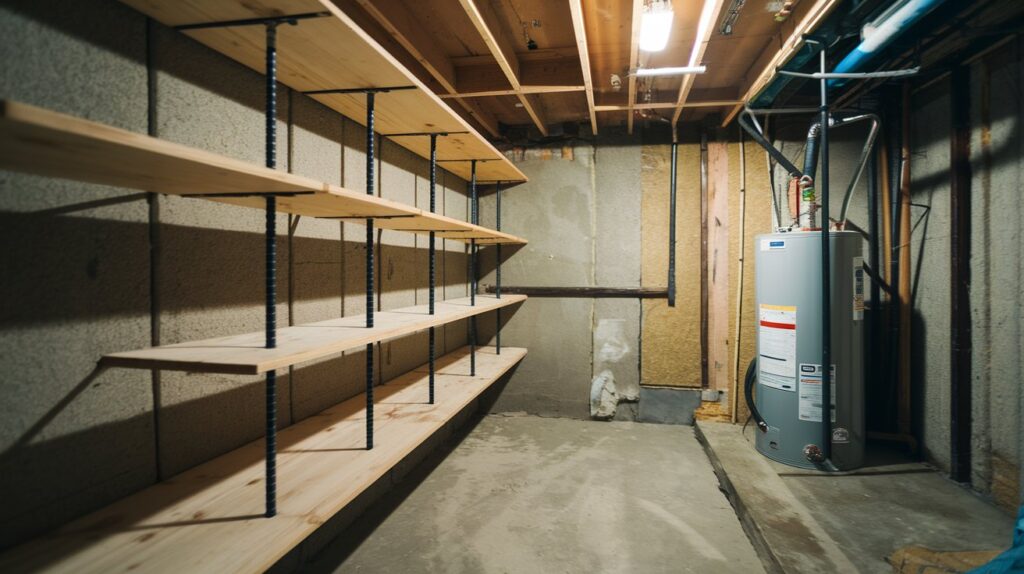Remodeling a basement is an exciting project for homeowners looking to add functional living space, increase home value, or finally put that unused square footage to good use. But it’s also a project where mistakes are common and costly. From structural oversights to design missteps, skipping essential prep work can undermine the entire renovation.
Pre-Remodel Planning Pitfalls
The decisions you make before swinging a hammer set the tone for your entire project. These early-stage mistakes can quietly sabotage your basement remodel before construction even begins.
1. Skipping a Professional Waterproofing Inspection
Before anything else, you need to make sure your basement is dry and will stay that way. Too many homeowners assume that if their basement looks dry, it is. However, moisture issues can be subtle, seasonal, or hidden behind walls.
A professional evaluation can reveal underlying problems like hydrostatic pressure, foundation cracks, or poor drainage systems. Moisture intrusion may be quietly at work beneath the surface, and finishing a basement without addressing it can lead to mold, rot, or even structural damage.
Using moisture barriers helps, but they aren’t a substitute for full basement waterproofing. Investing in this early step protects your renovation from the ground up.
2. Ignoring Local Climate and Soil Conditions
Where you live impacts how you remodel – homes in areas with high water tables or frequent rainfall demand more robust waterproofing systems than those in drier regions. Similarly, heavy clay soils can retain moisture and place pressure on foundation walls.
Tailoring your remodeling plan to local conditions ensures your finished basement will perform well over time, regardless of the weather outside.
3. Rushing the Timeline
It’s tempting to fast-track your remodel to meet a personal deadline, but cutting corners in the planning or drying phases can backfire. Waterproofing, in particular, takes time to inspect, install, and test. Skipping or rushing it can lead to missed problem areas or incomplete coverage.
Build in extra buffer time upfront. It’s far less expensive to wait a week than to rebuild an entire finished space after a leak. You may also need time to evaluate options like drainage mats, vapor barriers, or different sealants, depending on your basement’s condition.
Construction and Design Mistakes
Once the build begins, every material and design choice matters. These common missteps during construction can affect comfort, durability, and long-term maintenance.
1. Installing Flooring Over Damp Concrete
Once you’ve waterproofed, the next mistake is laying flooring before the slab is fully dry. Concrete retains moisture long after visual dampness disappears.
Installing vinyl, laminate, or carpet over a damp floor can lead to warping, bubbling, or mold growth. Always test moisture levels and install over an approved vapor barrier if needed. Consider flooring types designed specifically for basements, such as luxury vinyl planks or tile, which are more resistant to moisture.
2. Using the Wrong Insulation
Basement walls aren’t the same as above-ground walls, and you shouldn’t treat them the same. Standard fiberglass batts can absorb moisture and harbor mold when used below grade.
Instead, opt for foam board or closed-cell spray foam insulation. These materials resist water, offer high R-values, and are far better suited for basement environments. This not only prevents future moisture issues but also helps regulate temperature and reduce energy costs.
3. Failing to Address Exterior Drainage
Even the best interior waterproofing system will struggle if water is constantly pooling outside your home. Landscaping, gutters, and downspouts all play a role in keeping water away from your foundation.
Check for sloped grading, clean your gutters regularly, and extend downspouts at least 6 feet from your home. These minor fixes can prevent significant water intrusion later. In some cases, you may also need to install a curtain drain or swale to redirect surface runoff.
4. Overlooking Plumbing Infrastructure
Your basement may house critical plumbing systems: sump pumps, water heaters, laundry hookups, or bathroom drains. Remodeling without assessing the condition and layout of these systems is risky.
Before closing up walls or installing flooring, inspect for aging pipes, test sump pump reliability, and consider adding flood alarms or backflow valves for extra protection. Make sure that any new plumbing installed for bathrooms or wet bars is accessible in case repairs are needed in the future.
5. Forgetting About Ventilation
Basements tend to trap humidity, even after waterproofing. Without proper airflow, you could still end up with musty odors or mold issues.
Incorporate ventilation strategies into your remodel: install return vents, run a dehumidifier, and consider moisture-resistant drywall for extra defense. This keeps the air fresh and the environment healthy long-term. Proper airflow also improves comfort, especially if you plan on using your basement as a living space year-round.
Prep Work Is the Real Finish Line
A finished basement adds enormous value to your home, but only if it’s done right from the ground up. Rushing ahead without waterproofing or ignoring environmental conditions can sabotage even the most beautiful remodel.
Avoid these eight common mistakes to ensure your basement is dry, durable, and built to last. Whether you’re creating a home office, gym, or extra bedroom, starting with proper waterproofing gives you the strongest foundation for success.
Taking the time to plan well and build smart means fewer headaches later and a basement you’ll enjoy for years to come.

